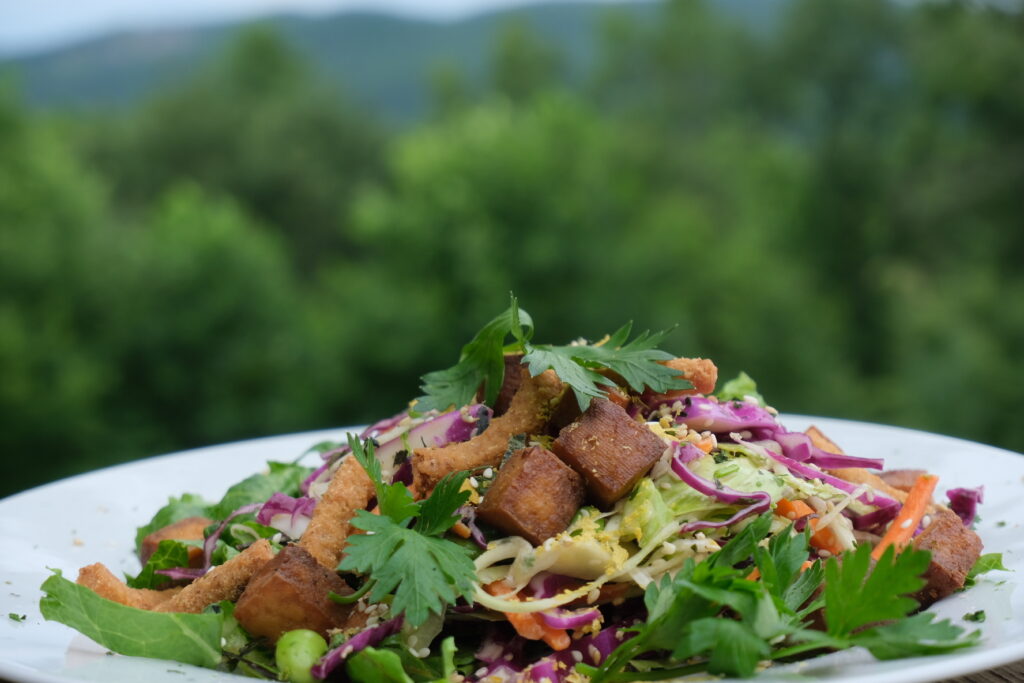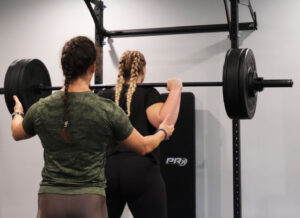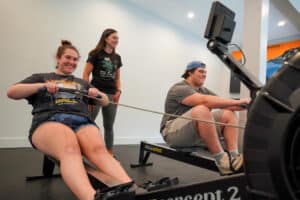When we make the commitment to embark on a new fitness plan or look to improve our health or physical performance, it’s no secret that proper nutrition is essential. Nutrient timing and meal composition are important for energy, recovery, and making you feel like your best self.
Before diving deeper into the physiological responses the body undergoes during exercise and how that pairs well with our nutrition, keep in mind that consistency and balance are of utmost importance. Developing a healthy relationship with both movement and food can best set you up for success in developing a healthy, happy lifestyle.
At Skyterra Young Adult, we encourage all of our guests to start the day with a very balanced breakfast, including protein, fat, and produce. This will properly set our guests up for fuel during morning movement while honoring hunger and fullness throughout the day. All guests eat three nutrient-dense meals together each day, with designated snacks in between. We touch on the importance of consistent meals and joyful movement for a sustainable journey.
Metabolic Response to Exercise
Every single minute, the body undergoes a series of physiological adaptations, building up and breaking down for proper functioning. With movement, many of these processes are happening faster to adapt to the level of demand that is needed.
Hormones, the body’s chemical messengers, are responsible for telling organs, tissues, and muscles to perform a designated action. As we exercise, our hormones adjust to meet the body’s needs.
Four main hormones are used in catabolism or breakdown, which include epinephrine, norepinephrine, cortisol, and glucagon. These hormones are specifically important for energy and adaptations within the body to maintain power. Epinephrine and norepinephrine are elevated to prepare for the breakdown of glycogen which is then converted to glucose and used as the body’s main energy source. Glucagon is released, stimulates fat breakdown, and raises blood glucose levels. Lastly, cortisol is released for carbohydrate and fat breakdown to increase blood sugars and to encourage the production of more glucose.
Four additional hormones are produced in conjunction for the purpose of anabolism, or building. Their main purpose is to allow glucose uptake of the cell and promote the growth of the muscles. Insulin is important for blood sugar regulation. As more energy is needed, insulin levels increase, encouraging higher glucose uptake. With increased energy availability, increased muscle action and protein synthesis are observed. Testosterone, IGF-1, and growth hormone are released with the release of insulin. All three work together to increase protein synthesis and promote growth, and muscle size.
As we further explore these adaptations with various types of movement and intensities, nutritional patterns and timing become very important when it comes to achieving your fitness goals and desired outcomes of the type of movement you choose to engage in.
Macronutrient Role in Performance and Recovery
Macronutrients are essential nutrients found in food that provide our bodies with energy. The three macronutrients include carbohydrates, proteins, and fats. Carbohydrates are our body’s main fuel source, providing energy to our brain and body’s cells. Proteins are used as building blocks, supporting growth and repair. Fats are used for energy in addition to storing vitamins, supporting cell function, regulating temperature, and upkeeping our hormonal health. Each macronutrient plays a key role in movement, to provide energy, support recovery, and hormonal function throughout the action.
Nutrient Timing
Nutrient timing involves eating specific nutrients at the desired time to achieve optimum results. Nutrient timing around movement can be broken down into three phases: energy phase, anabolic phase, and growth phase. Physiological adaptations change depending on the movement and the phase in which the body is in.
Before we deep dive into the science, eating enough to support any movement and essential body functions is the highest priority. If we are under-consuming, performance, recovery, and normal metabolic functions will take a hit.
Energy Phase
Phase one, the energy phase, begins 30 minutes before the workout and spans the duration of the movement. During this period, the body is relying heavily on glucose as its main fuel source. Muscle glycogen is quickly depleted, which is the main contributing factor to muscle fatigue. Fat stores are used as a secondary fuel source. During this phase, quick-digesting carbohydrates are essential to optimize both endurance and resistance training. Additionally, adding a small amount of protein to minimize blood sugar spikes and initiate the recovery process is helpful.
Anabolic Phase
Phase two, the anabolic phase, ranges between 45 minutes to an hour post-workout. Insulin sensitivity is highest and muscle growth and repair is beginning. A combination of carbohydrates and protein can enhance recovery and aid in muscle repair.
Growth Phase
Phase 3, the growth phase, occurs between 18-20 hours post-exercise, typically lasting the remainder of the day. Within this time, the majority of growth and repair occurs. While carbohydrates are still important, placing an emphasis on protein will optimize adaptations. Balanced meals, including protein, high-fiber carbohydrates, vegetables, and fat will support the whole body.
Skyterra Young Adult guests are educated, encouraged, and provided balanced, nutrient-dense meals 3 times a day to support all aspects of health, with these three phases in mind, as the majority of guests intentionally move their bodies through exercise in some way, shape, or form every single day.
What to Eat Before You Move
As we learned the importance of pre-workout fuel, an emphasis on carbohydrates and protein is essential. Whether your workout is early morning, afternoon, or evening, we can optimize your performance and kickstart recovery with a great meal or snack.
If you are considering a meal prior to exercise, allow 3-4 hours to fully digest before participating.
Meal Ideas
- Oatmeal with chia seeds, banana, and peanut or almond butter
- Peanut butter and jelly sandwich
- Omelet with vegetables and toast
- Brown rice with ground turkey and vegetables
- Wrap with sliced turkey, ham, or chicken, cheese, and vegetables
A snack 30 minutes prior to exercise can help with energy levels and hunger, depending on when your last meal occurred. When choosing a snack close to movement, aim for a quick, digestible option.
Snack Ideas
- Apple with peanut butter
- Peanut butter energy bites (or store-bought energy bar like an RX bar or larabar)
- Smoothie made with frozen fruit, greek yogurt, honey, and milk of choice
- Frozen berries with granola
- Hard-boiled egg and banana
What to Eat After You Move
As much as a pre-workout meal or snack is important, your post-workout nutrition is of utmost importance. Within an hour or two, prioritize a balanced meal, consisting of protein, fiber-rich carbohydrates, and fat. Whether you are on the go, in the comfort of your own house, or out with friends, have a plan that you feel comfortable and confident with. If you are unable to get a meal in within this time, aim for a snack with carbohydrates and protein to allow the muscle to begin the recovery and rebuilding process. Prioritize water throughout the day to maintain proper hydration.
Meal and Snack Ideas
- Chicken with baked potato and roasted vegetables
- Smoothie with greek yogurt, protein powder, frozen fruit, nut butter, spinach, and milk of choice
- Grain bowl with choice grain, choice protein, choice vegetable, and sauce or dressing
- Scrambled eggs with yogurt parfait topped with granola, berries, and chia seeds
- Cottage cheese with fruit or vegetables
- Sandwich with sliced turkey, ham, or chicken, cheese, lettuce, tomato, and avocado
- Greek yogurt with granola, dried or fresh fruit, and honey or maple syrup
- Burrito with ground meat, beans, tomatoes, avocado, and cheese
- Loaded sweet potato with ground chicken or turkey, bell peppers, black beans, corn, and salsa
- Chicken, egg or tuna salad with crackers
In conclusion, we know that navigating food and movement can be challenging. Remember, your body is going through lots of adaptations and physiological functions in order to perform your activities. We have to give it proper nutrients in order to succeed.
Aim to prioritize easily digestible carbohydrates with a small amount of protein prior to a workout. Meal and snack size will depend on the length of time to digest before movement. With post-workout, recovery and rebuilding is the body’s goal. Aim to prioritize protein with a fiber-rich carbohydrate. Choose things that make your body feel energized, both physically and mentally, and you will be set up for success when it comes to nutrition throughout your day.






